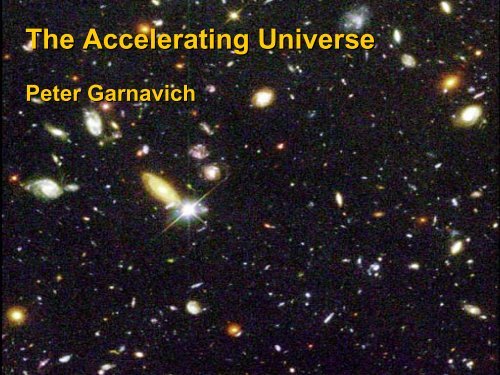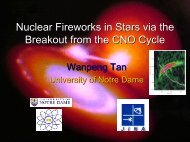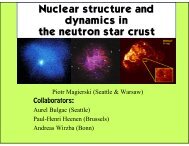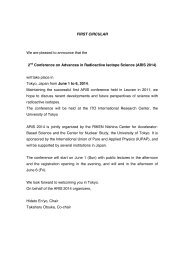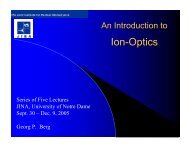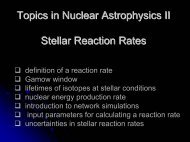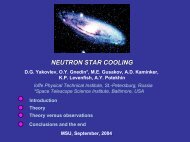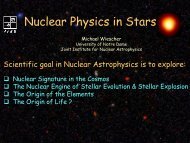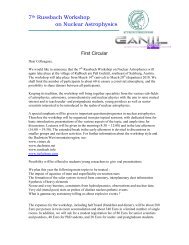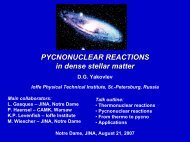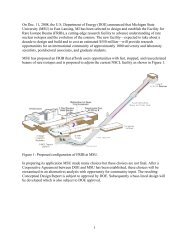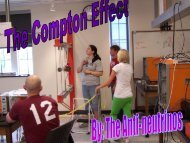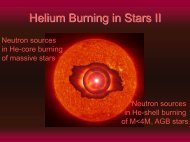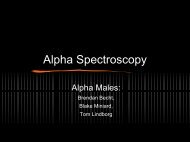The Accelerating Universe
The Accelerating Universe
The Accelerating Universe
You also want an ePaper? Increase the reach of your titles
YUMPU automatically turns print PDFs into web optimized ePapers that Google loves.
<strong>The</strong> <strong>Accelerating</strong> <strong>Universe</strong><br />
Peter Garnavich
A <strong>Universe</strong><br />
of the<br />
Unknown<br />
Ordinary matter makes<br />
up a small fraction of<br />
the mass/energy.<br />
Dark matter and dark<br />
energy dominate.
<strong>The</strong> <strong>Universe</strong> is Expanding!<br />
1929 Edwin Hubble measured<br />
the Doppler shift of nearby<br />
galaxies and found a simple<br />
relation with their distance –<br />
v = H 0 d<br />
velocity<br />
distance<br />
Easy to measure<br />
velocity. Hard to<br />
measure distance!
<strong>The</strong> Hubble Expansion<br />
Space itself is expanding. Every point in space is getting further from every<br />
other point. Everybody sees the same thing!<br />
Imagine the Earth’s radius got larger…<br />
Distance from South Bend to Mishawaka would not change as quickly<br />
as the distance between South Bend and New York City.
Hubble was Wrong (sort of)<br />
Hubble’s 1929 estimate of the expansion rate was off by<br />
a factor nearly 10!<br />
<strong>The</strong> next 60 years were spent sorting out the distance scale<br />
<strong>The</strong> correct<br />
answer is:<br />
70+\- 7
<strong>The</strong> Doppler Shift – Measure the Velocity<br />
Doppler shift: Δλ<br />
Δλ v<br />
−− = − = z<br />
λ c<br />
Orbiting stars will make<br />
sinusoidal Doppler shift<br />
over an orbit.<br />
z=0.16
Measuring Distance is Simple but Hard<br />
If street lights have<br />
the same wattage,<br />
then their relative<br />
brightness is a clue<br />
to their distance:<br />
<strong>The</strong> Inverse-Square<br />
law<br />
A light bulb twice as far as an identical<br />
bulb will appear 4 times fainter
Expansion in <strong>The</strong>ory<br />
Hubble law discovered in 1929 could have been predicted<br />
by Einstein in 1915 (General Relativity)<br />
Einstein’s equations for gravity’s effect on space-time<br />
showed either an expansion or contraction should occur:<br />
8πG ρ Λc 2<br />
H 2 = -------<br />
+ ----<br />
3c 2 3<br />
H is the expansion rate at any time and H 0<br />
is the<br />
expansion rate now => the Hubble constant<br />
ρ is the density of matter in the universe=> source of gravity<br />
v=H 0 d<br />
<strong>The</strong> equation has two solutions: positive or negative expansion.<br />
Einstein thought the <strong>Universe</strong> should be static, so he added a term<br />
he called the “cosmological constant” that can cancel the matter’s<br />
gravity => his biggest blunder! (he later said)
Supernovae – Maybe Standard Candles?<br />
Can outshine all the other 100 billion stars in their<br />
host galaxy. Make most of the elements heavier than H,He<br />
Zwicky –1930 suggested<br />
they are the collapse<br />
of a massive star when<br />
it runs out of fuel.<br />
Really two completely<br />
different types:<br />
Massive stars-core<br />
collapse<br />
“White Dwarf” –<br />
detonation
Detonation of a Small Star – Type Ia<br />
Normal stars like the Sun fuse H => He => C in their cores.<br />
When their fuel is exhausted gravity takes over and compresses the t<br />
star until the matter becomes “degenerate”: quantum mechanics<br />
prevents<br />
electrons from getting any closer => White Dwarf<br />
White Dwarf stars are about the mass of the Sun but the size of the<br />
Earth<br />
Electron degeneracy can<br />
only support a WD for<br />
masses <br />
igniting the Carbon in<br />
the center… BOOM
“Explosion” of a Star – Type Ia<br />
Companion donates mass to white dwarf until ~1.4 M sun<br />
Once fusion of C+O starts in the core =><br />
the burning front moves out through the star leaving<br />
0.5 M sun Nickel which decays to Cobalt (half-life life 7 days)<br />
and then decays to Iron<br />
(half-life life of 2 months)<br />
If the fusion front moves at<br />
greater than the sound<br />
speed => detonation<br />
Too much 56 Ni<br />
56 Ni<br />
Carbon and Oxygen<br />
White dwarf<br />
Iron<br />
If the fusion front is<br />
subsonic => deflagration<br />
Too little 56 Ni<br />
56 Ni<br />
Range of peak brightness<br />
probably due to 56 Ni spread
Type Ia SN:<br />
exploding white<br />
dwarfs<br />
Computer<br />
Model:From<br />
crinkled flames<br />
grow lumpy<br />
supernovae<br />
Things more<br />
complicated than<br />
simple spherical<br />
model
Type Ib/c removed<br />
Original<br />
Hubble<br />
Diagram<br />
Corrected for decline rate<br />
Corrected for Dust Extinction<br />
8% Distance Error
How Much<br />
Matter?<br />
Matter density<br />
determines the<br />
gravitational pull<br />
that slows the<br />
expansion<br />
Deceleration rate<br />
measures the<br />
density of matter<br />
created in the<br />
Big Bang.<br />
Density only about:<br />
10 -29<br />
gram/cm 3
Extending the Hubble Diagram<br />
<strong>The</strong> linear Hubble Law is only an approximation. <strong>The</strong> rate of expansion in the<br />
past depends on the matter/energy density of the universe.<br />
H 2 (a) H 2 = (a) H 02 = [ HΩ m a -3 + Ω Λ + (1- m - Ω Λ ) a -2 02 [ Ω m a -3 + (1- Ω m ) a -2 ] ]<br />
Redshift = velocity<br />
Hubble Diagram<br />
Look far enough<br />
⇒See deviation<br />
from a line<br />
Distance between 2 galaxies<br />
Size<br />
God’s Eye View<br />
Distance from Us<br />
Time
Searching for Distant<br />
Supernovae<br />
Take wide field images of the<br />
sky. Come back in a month<br />
and do it again => look for<br />
things that change.
Searching for Supernovae
Advantage Space<br />
Our atmosphere blurs stars: even a small telescope has a<br />
big advantage in space.
Distant Hubble<br />
Diagram<br />
Both groups found that<br />
the type Ia supernovae<br />
were fainter than they<br />
expected for a matter<br />
dominted universe<br />
In fact, the universe was<br />
not decelerating, but<br />
was accelerating =><br />
Requires another kind<br />
of “energy”. A vacuum<br />
energy or<br />
“cosmological constant”
Type Ia – Not Standard Candles<br />
But st
Acceleration<br />
<strong>Universe</strong> will<br />
look very<br />
different in<br />
future<br />
if there is a<br />
Vacuum energy<br />
Space will be<br />
stretch out<br />
very quickly<br />
due to the<br />
acceleration<br />
Size<br />
Galaxies will<br />
disappear…
<strong>The</strong> Big Rip<br />
Phantom Energy: a<br />
form of Quintessence<br />
that has an equation<br />
of state w
What is the dark energy?<br />
Both the m
Things Dark Energy Might Be:<br />
1) Einstein’s Cosmological Constant<br />
2) <strong>The</strong> “vacuum” has a non-zero energy<br />
3) A new particle with very low mass<br />
4) Gravity leaking from large extra dimensions<br />
5) General Relativity is wrong on<br />
large scales<br />
0) Something we have not<br />
thought of
A Dark, <strong>Accelerating</strong> <strong>Universe</strong><br />
0.1% visible matter, 25% dark matter, 75% dark energy
Hubble Ultra Deep Field (UDF)<br />
1 million second long<br />
exposure staring at<br />
one spot on the sky.<br />
Hubble Deep Field (HDF)<br />
In 1997 => shorter<br />
exposure and not as<br />
sensitive a detector.<br />
ACS is a new instrument<br />
added to Hubble on<br />
the previous repair<br />
mission
Recombination – 14 billion years – as<br />
far back as we can see…
Content of the <strong>Universe</strong> Effects Age<br />
Gravity pulls galaxies together – slows the expansion.<br />
“deceleration” means 1/H0 is an over-estimate estimate of the age.<br />
Slope now<br />
is the Hubble<br />
parameter.<br />
But the<br />
expansion<br />
could have<br />
been faster<br />
in the past<br />
and slowed<br />
by gravity
Inflation<br />
Expanded a small piece of the <strong>Universe</strong>: implies there is<br />
much of the <strong>Universe</strong> outside our horizon. Which may have<br />
very different constants and properties.


